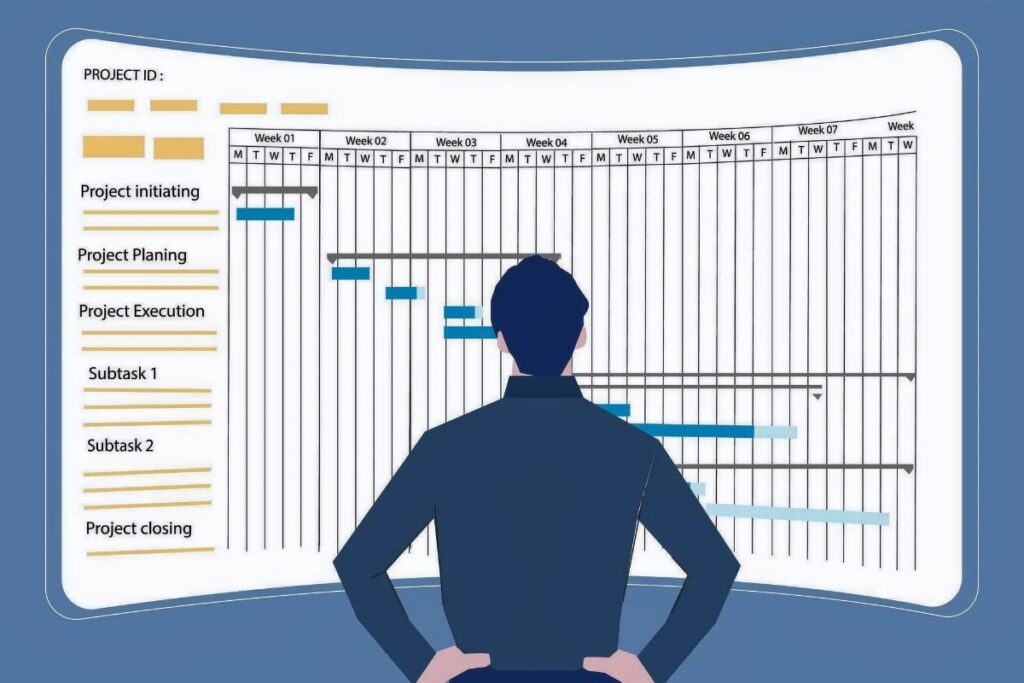One of the most common problems in projects is exceeding timelines and budgets. You could even argue that failed projects don’t truly exist — there are only those whose deadlines stretch into infinity, and whose budgets have already run out. Notably, both the client and the contractor suffer from missed deadlines.
The client doesn’t get the expected results, and the contractor doesn’t receive the expected payment. This shared problem could, in theory, unite both parties — but in reality, it often adds further strain to the relationship. So how can we ensure that timelines and budgets are consistently met? We’ve managed to make some progress in this area.
Before sharing our experience, let’s address a few fundamental questions: what does the client want, and what does the contractor want when delivering a project?
Let’s assume the client genuinely wants to complete the project. They have a defined budget and are ready to pay for results. Naturally, they want to get as much as possible for their money — just like you would when renovating your home. And like any homeowner hiring a contractor, the client may suspect that the contractor will inflate the budget. That’s a reality of doing business.
What Does the Contractor Want?
In most cases, the project team wants to do the work, while company leadership wants to secure the contracted payment. An experienced contractor knows the client’s desires — and also knows the budget tends to run out just as those desires peak. So they often try to stretch the budget as much as possible.
Both parties are acting rationally from their perspectives. Yet, projects often begin without fully aligning expectations, which only worsens misunderstandings as the project progresses.
Below are some of the key principles and methods we use to improve adherence to timelines and budgets. Hopefully, they’ll help you improve the quality of your own projects.
1. Defining Project Boundaries
The first crucial step is developing a Project Scope Document. This is a high-level document outlining client requirements — not as detailed as a formal Statement of Work (SoW), but still substantial.
The document is created by a consultant or business analyst (from the contractor’s team) through interviews with key client stakeholders. It describes all tasks to be addressed during the project, as well as what will not be addressed. This phase usually takes one to two weeks, including alignment with the client.
At this point, there may be no contract yet — and therefore no official project. So who pays for this preparation, scope definition, and planning effort? That’s a question each organization must answer for itself. But one thing is clear: estimating project cost and timeline without defining scope is pure guesswork. No wonder budgets and timelines often spiral out of control.
2. Designing the Architecture
Once the scope is agreed upon, the consultant passes it to the project architect — the one who will later be responsible for implementation.
The architect analyzes the scope, asks clarifying questions, and designs a high-level solution. They draft a short architectural overview: what technologies will be used, what components need to be built, and how many days each task may take.
This can be formalized as a separate Project Estimation Document, or as comments in the Scope Document. Typically, this process takes two to five days. Architect questions often reveal overlooked areas, which helps reduce risks later.
A joint meeting is then held with the consultant, architect, and project manager to finalize the architecture and estimates. System constraints and client responsibilities (e.g., providing infrastructure, scheduling training rooms) are also documented.
3. Work Planning
Next comes project scheduling and resource planning. The architect defines which specialists are needed, the order of task execution, and task dependencies.
The project manager consolidates this data into a detailed project plan. Initially, tasks are laid out sequentially. Then they are mapped to resources, taking into account:
- The client’s desired timeline
- Optimal team composition
- Minimal staffing with maximum productivity
This helps calculate how long each specialist will be involved — which forms the basis for the project budget.
We use MS Project for scheduling. Task duration is based on effort estimates from the architect, but must be adjusted according to who will execute the task. Knowing the productivity of each specific developer is essential — this is the third key factor in accurate planning.
You must also apply this logic to other project roles: testers, systems engineers, technical writers, etc. Real planning starts only when the project team is assembled.
4. Budget Estimation
Once the plan is built, we know who will be involved and for how long. At this point, the project manager calculates the budget in an Excel spreadsheet, using parameters like:
- Role
- Duration (in months)
- Utilization rate
- Hourly rate
- Labor hours
- Monthly and total cost
Here’s a simplified example:
| Role | Duration | Utilization | FTE | Labor (hrs) | Rate/hr | Monthly Cost | Total (excl. VAT) |
|---|---|---|---|---|---|---|---|
| PM | 5 mo | 0.5 | 2.5 | 420 | $180 | $30,240 | $75,600 |
| Lead Consultant | 4 mo | 1.0 | 4 | 672 | $140 | $23,520 | $94,080 |
| Architect | 5 mo | 1.0 | 5 | 840 | $135 | $22,680 | $113,400 |
| Developer, Tester… | … | … | … | … | … | … | … |
This is how the project budget is formed. Budgeting usually takes an additional 2–3 days.
The fourth key principle: we derive the budget not just from task effort, but from resource allocation duration. Labor is the contractor’s primary cost driver — if resources stay on longer than planned, the company loses money. That’s why planning and monitoring must focus on people’s time on the project, not just task estimates.
5. Finalizing Scope, Schedule, and Budget
By this point, we’ve produced:
- The Scope Document, agreed with the client
- The Project Estimation, with architecture and task complexity
- The Project Plan
- The Budget
This is a comprehensive picture of what needs to be done, how, how long it will take, and what it will cost.
These four outputs are submitted to the client. The schedule and budget guide the client’s decision-making. The requirements are the levers that both client and contractor can adjust if changes are needed.
Since the budget is fully transparent, reducing time and cost means removing or simplifying requirements. We don’t calculate cost per requirement — instead, we rely on the architect’s complexity estimates.
If requirements are revised, the project manager replans using the same principles: minimal time, optimal staffing. The scope, budget, and schedule become contractual commitments. This entire scoping and planning phase usually takes 2 to 6 weeks.
Who pays for it? In our view, both client and contractor should share the cost. If the client is willing to invest in estimation, it signals their seriousness. If the contractor is willing to work at cost (or below), it shows commitment and encourages fast, thorough planning — because future risks are theirs.
6. Managing Timeline and Budget
With the estimate, schedule, and budget approved, you’re ready to sign the contract. But there’s one more question: What is the contractor actually selling?
On one hand, the contractor sells results — a fixed-scope deliverable (i.e., a fixed-price contract). On the other, the budget is based on resource time (i.e., time & materials).
This creates contractual ambiguity. The solution lies in agreeing on clear change management principles:
- The contractor guarantees to meet the agreed scope, timeline, and budget — if the scope remains unchanged.
- If work is completed ahead of schedule, the contractor’s team will continue working (within budget) on additional tasks.
- If scope changes occur but don’t affect time and cost, the contract remains valid.
- If scope changes require extra resources, a separate agreement is signed and the client pays for the additional effort.
Under this model, the contractor cannot profit from budget savings — since the full amount must be worked off. But the client is incentivized to control scope, knowing that changes mean extra cost. And the contractor is motivated to maintain high quality, because client satisfaction now depends on specialist performance.
Summary
The key to staying on budget and schedule lies in how you estimate and contract your project from the very beginning:
- Define the project scope thoroughly before estimating.
- Design the system architecture and document it clearly.
- Base task duration on the actual productivity of assigned specialists.
- Estimate budget based on time commitment, not just effort.
- Include client-side responsibilities in the scope documentation.
- Commit resources accordingly and plan contractually for changes.
From there on, your only job is to monitor scope compliance and mutual obligations — and deliver your project with confidence.




